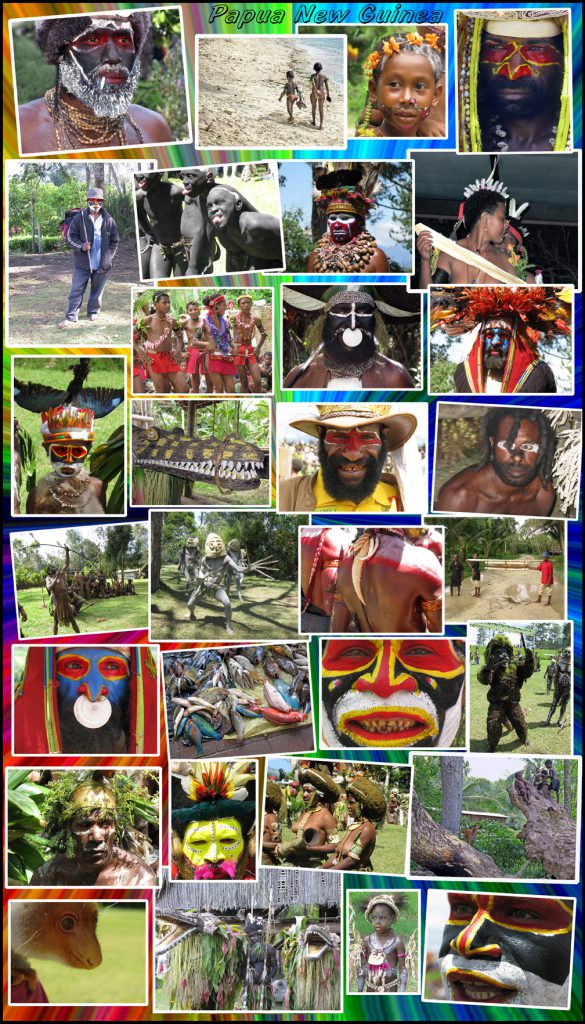
We didn’t mean to fall in love with PNG when we first went there in October of 1998–all we meant to do was enjoy ten relaxing days scuba diving from a live-aboard dive boat. We’d little interest and less knowledge of the country but decided, seeing we were there and some of the other divers were going to take a trip inland, we might as well go with them.
The islands of the South Pacific have seduced so many who’ve travelled there—explorers, scientists, artists, writers. And us. From the moment we arrived back home, we started longing and planning to go back. In August 2008, my husband and I returned. There were so many great experiences but, long as this report is, it just skims the surface of this wonderful time. (Update 2018: The love affair continues…we are returning again later this year.)
The journey
We both carried a Rick Steves convertible backpack (they weigh less than 3lbs each when empty) and were very pleased with them. When we left home mine, fully loaded, weighed 11 lbs and my husband’s 13 lbs. Because we’d be returning to the Port Moresby hotel during and at the end of the trip, to protect any fragile souvenirs we took an empty small hard sided suitcase, leaving it at the hotel for the duration. For the flights home, we checked our backpacks (which arrived two days after we did) and carried on the 19” suitcase with our treasures.
The flight from Los Angeles to Sydney on Qantas was pleasant. Service was good and friendly. I’d dreaded the thought of over 14 hours on the plane but, after the meal and watching a movie, went to sleep and next thing I knew was being woken up by my husband for breakfast. We landed at 6 a.m. on Sunday morning.
Pre-PNG: 4 days in Sydney.
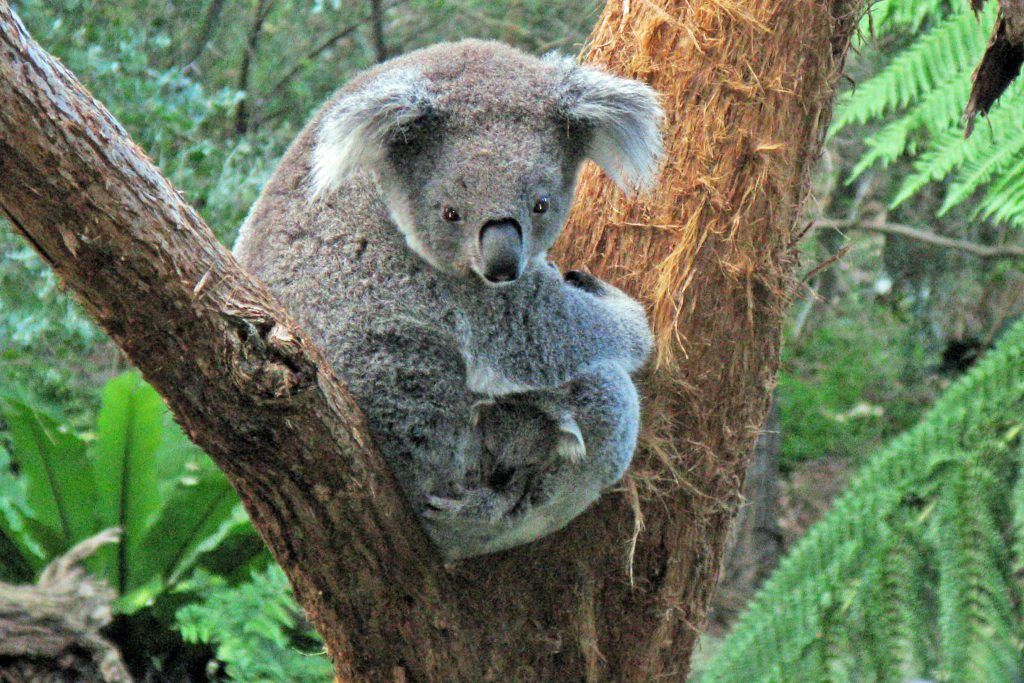
Koala and baby at the Taronga Zoo, Sydney
I had set me a personal challenge–to spend no more than 500 USD, including accommodation, for the four days we were in Sydney (didn’t want to stay with our Newly Discovered Relatives just in case we didn’t get on, a needless worry, they were wonderful). I’d managed to save $500 on each ticket by flying into Sydney and then on to PNG instead of Brisbane/PNG, so wanted to see if I could do our Australian part of the trip for “free”.
We booked into The Old Rectory (appears to cater to middle-aged backpackers) at 80 AUD/night. It is close to the airport. The couple that run the B&B rent the house from the Catholic Church, which won’t put any money into upkeep, so the place very definitely needs maintenance—peeling plaster and so on, but is kept spotlessly clean by the young couple. Breakfast is included in the price: cereal, breads, jams, tea, coffee—help yourself. The fridge shelves and larder storage are numbered so guests can keep their purchases separated.
As soon as we settled in we called our relatives, went to their house, sorted through some family memorabilia, were able to put names to some relatives they hadn’t be able to identify, had a light lunch with them, then out on their sailboat for the rest of the day. What a great introduction to Sydney—sailing up and down the harbour and a little way into the ocean over sparkling waters.
That evening they fed us dinner, a couple of glasses of wine, dropped us off at our B&B, we fell into bed and, cliché or not, we were asleep before our heads hit the pillow.
Woke up just a few minutes before six the next morning and watched as the first planes of the day flew over the house.
This was early August and although the days were bright and sunny, in the mid 50s F, early mornings in the unheated house/bathroom were miserable—we had come from over 100+ degree F temperatures in Colorado—so shivered through our morning showers. But hey, we’re on vacation!
The next few days we wandered around Sydney…
…all the usual sites including the Opera House, Botanical Gardens, Taronga Zoo. On Circular Quay heard a didgeridoo, followed the sound, and found a couple of most charming aborigines playing and entertaining. I couldn’t resist buying one of their CDs, they have some really good tunes.
Our first lunchtime we discovered meat pies from a vendor at Circular Quay, immediately became hooked on them, and took several back to the B&B to reheat for future suppers, along with a bottle of cheap plonk.
Took public transportation everywhere. It was inexpensive, easy to use, and efficient.
We are thoroughly enamored of Sydney and can’t wait to go back there as well as traveling elsewhere in Australia. The people were wonderful and most helpful. We only had to look like we needed directions, or where to get off the bus, and so on, and someone was asking if they could help us.
Our final evening we took our relatives out to a local Thai restaurant for dinner. This took us a little over my goal of $500—but I still felt pleased at getting so close to my challenge.
Day 1: Papua New Guinea: Arrive and overnight in Port Moresby.
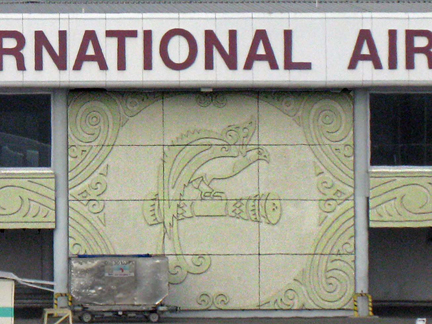
Port Moresby International Airport
All went smoothly with the flights to Port Moresby via Brisbane and we arrived to the cheerful playing of a group of local musicians. Met up with our ElderTreks guide, who was in his early thirties, and the other ten group members, all from the U.S. except for one Canadian. They ranged in age from 56 through 82, pleasant, well traveled, and fit. On days with a long road journey, we’d get out our vehicle and walk for a mile or so.
My husband had decided to grow his beard so he didn’t have to struggle with shaving under, at times, difficult conditions, and if he hadn’t, he’d have been the only man without one. Our Eldertreks guide, Nitin, had shaved his off before the trip but both he and the local guide, Rex, who was with us throughout the whole trip, let their beards grow as the days went by.
Day 2: Fly to Mt. Hagen. Rest of day at Paiakona Village for mini show. Overnight Hagen.
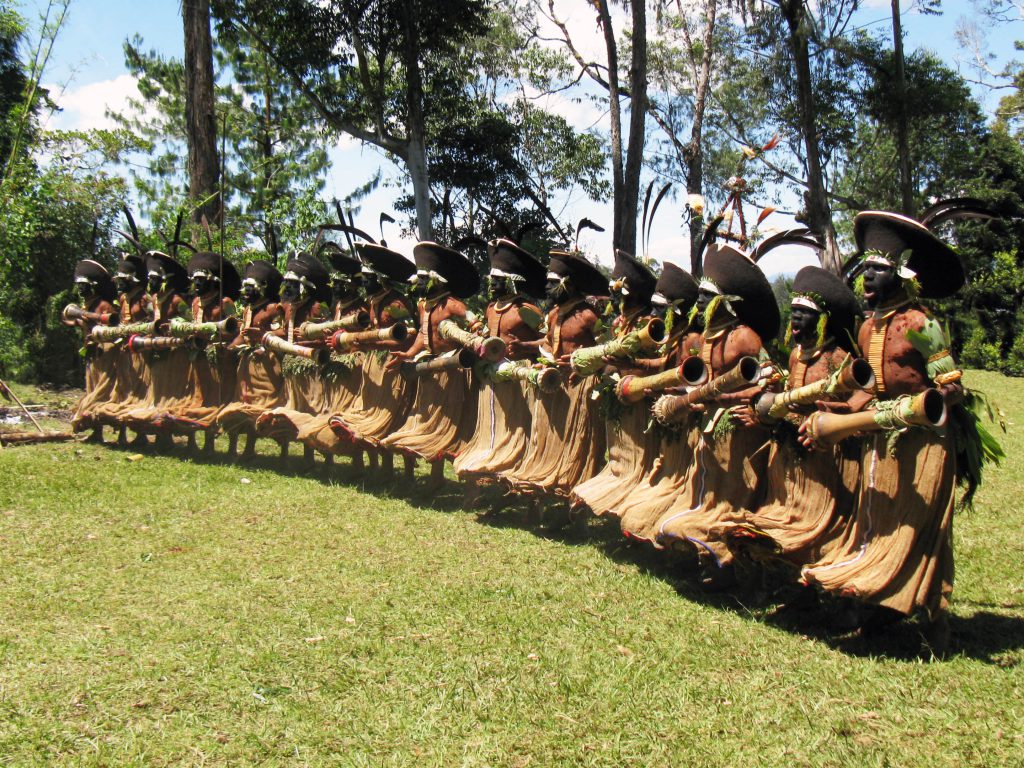
Sili Muli tribe participants at the Paiakona Village mini show
After a quick visit to the hotel, off we went to the mini sing-sing at Paiakona village. We enjoyed it more than the main one next day at the Mt. Hagen fairgrounds, I think because we were right in the thick of the action as they practiced for the coming competitions the following day. I got some fabulous photos.
While in the Highlands I’d hoped to find the Huli Wigmen I‘d photographed on my previous visit and give them prints. As I was wandering around, peering into faces, a man asked me who I was searching for, I showed him my photos, and he led me to “my” Huli.
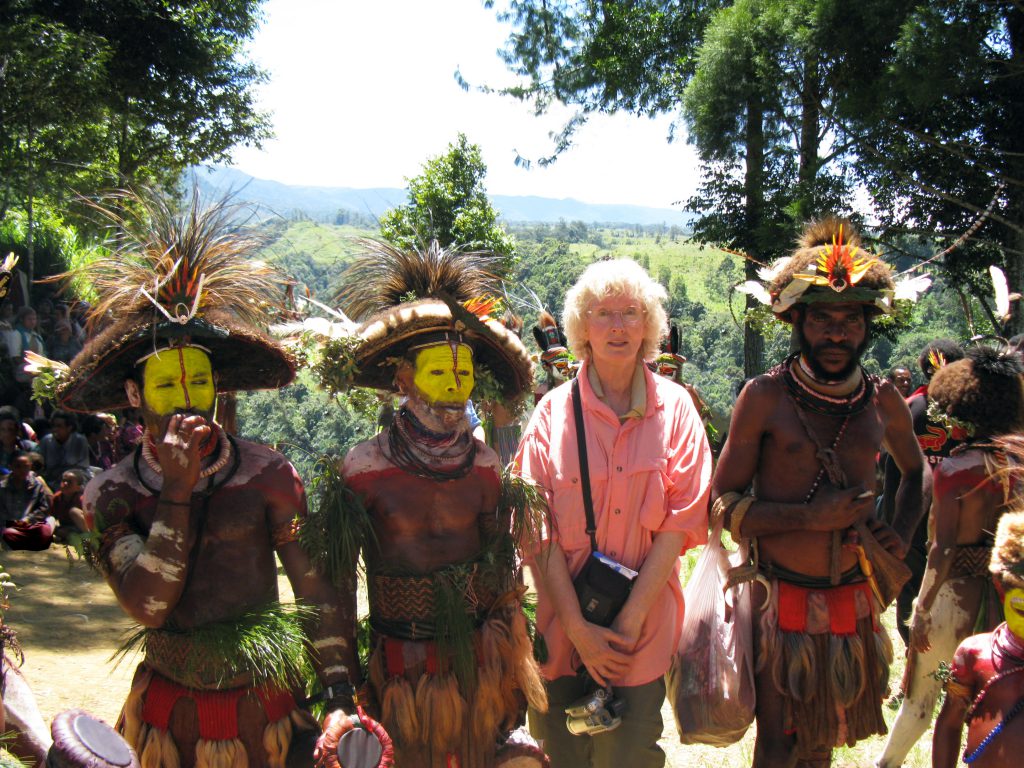
Eve with Huli Wigmen
They were very, very happy to get the prints—they’re familiar with seeing themselves in the back of digital cameras but don’t have many actual paper photographs. They were also excited to see my photo of their witchdoctor, Dr. Pajia, and said they’d take it to him.
On the way back to the hotel that evening, our local guide, Rex, asked if we wanted to meet his family, which we very much did, so stopped by his family compound for a brief visit. Everything was well kept and thriving and he had a delightful family.
Day 3: Mt. Hagen Cultural Show…out-dress, out-dance, out-sing.
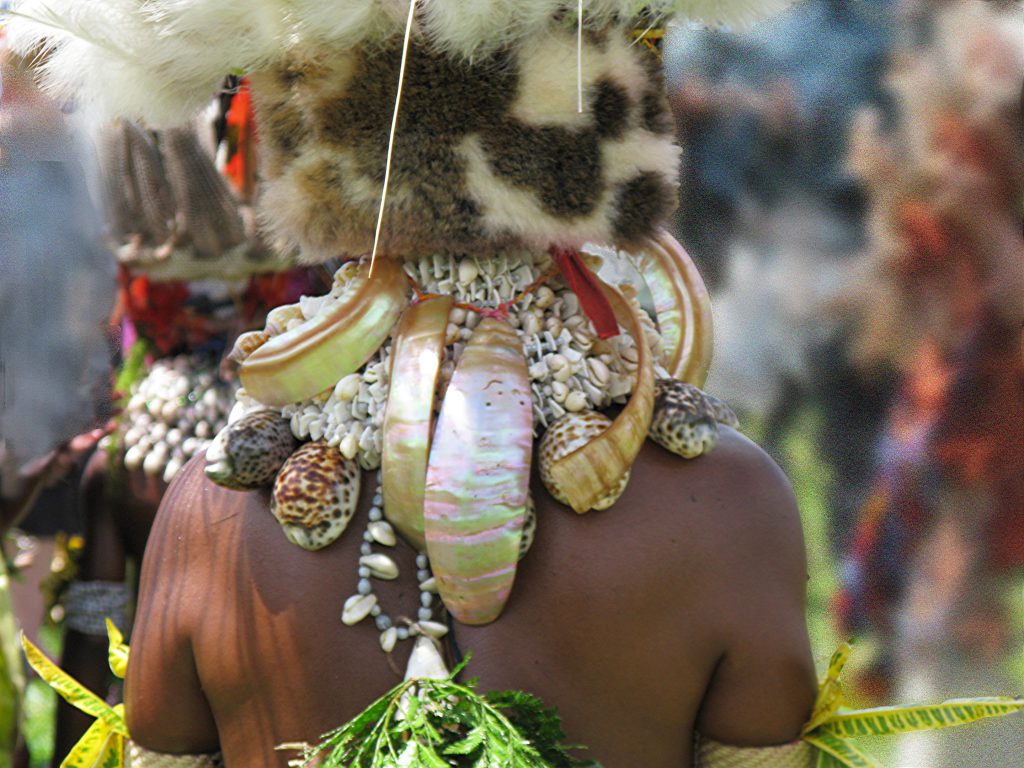
Mount Hagen Cultural Show
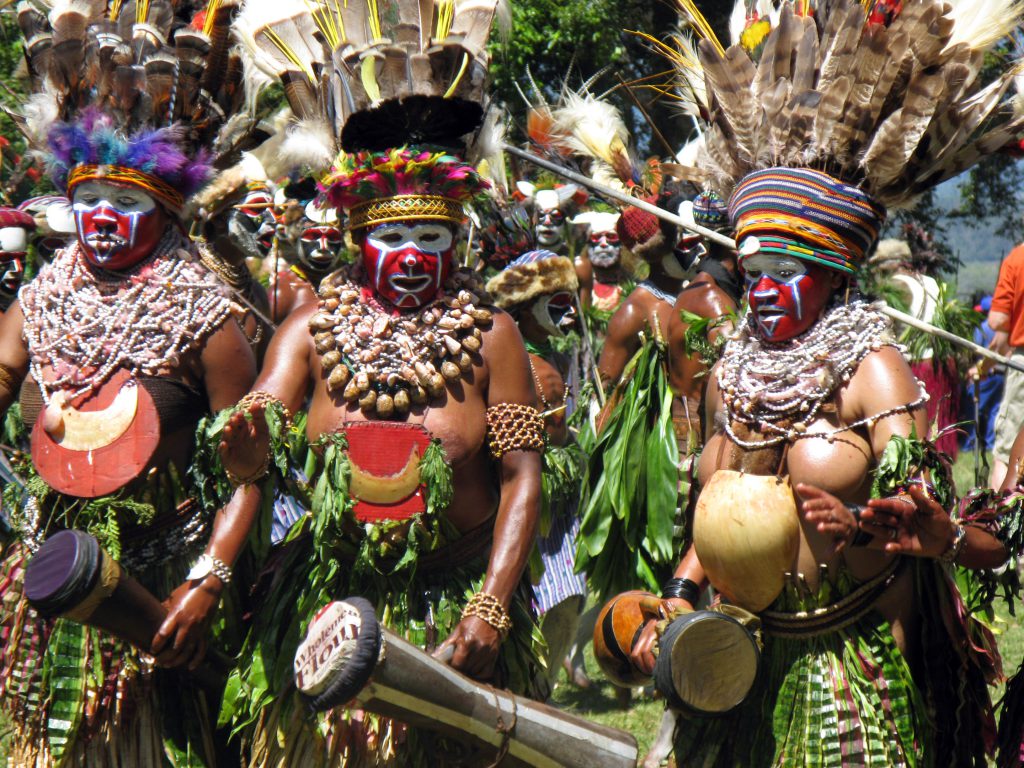
These beauties are considered the equivalent of Hollywood’s Rodeo Drive trophy wives
Bright and early we were at the Mt. Hagen showgrounds, even before many of the tribes had arrived. Wandering about and watching people getting ready was most interesting and a chance for more photos.
Nitin arranged for us to all get a small face painting.
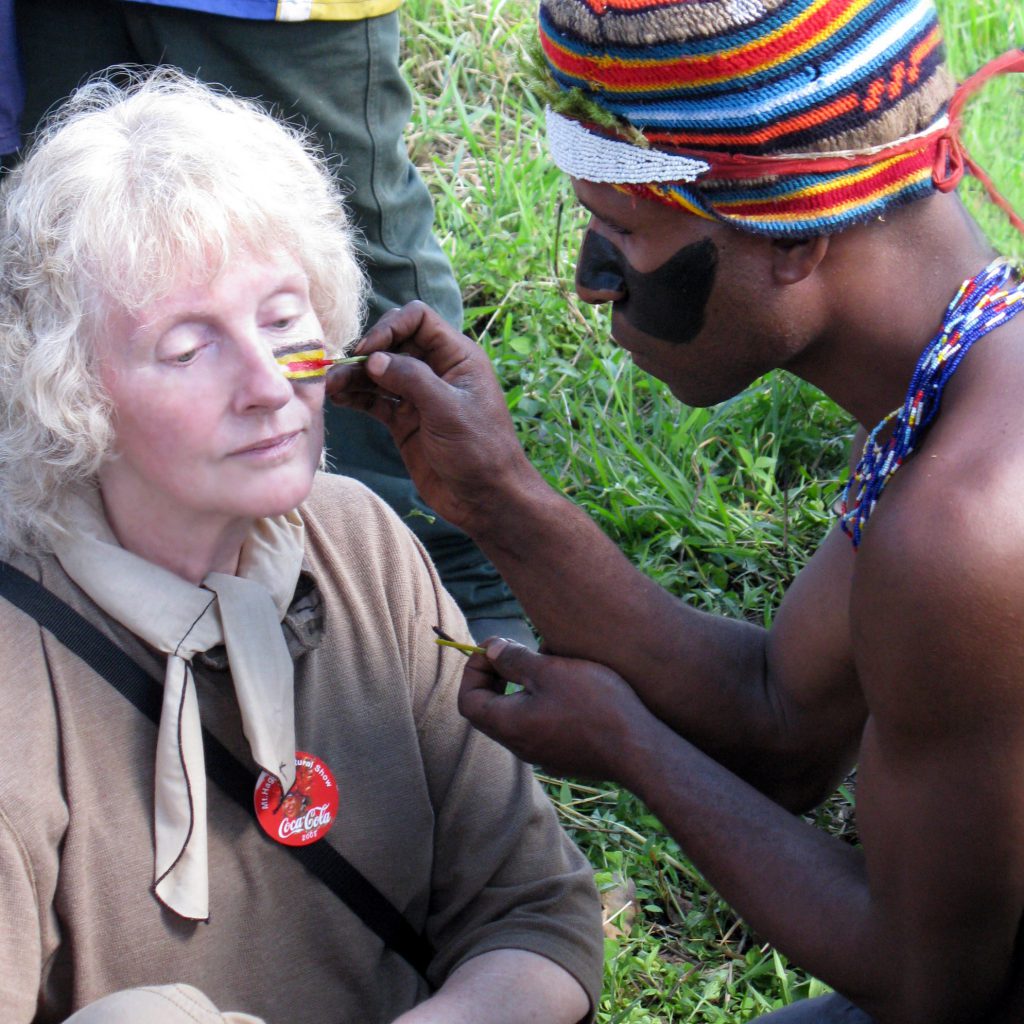
Face painting
The energy the various groups put out during the competitions was impressive, especially the women. Some of them were loaded down with shells around their necks and other decorations on their traditional dress, yet they danced and sang and danced for hours in the hot sun. The variety of costumes was amazing.
Afterwards, on the field, took many more photos, though with around 200 other visitors also wanting to do the same thing, it was difficult to get a picture without other tourists in it.
Every tribe was impressive in its own way but my favorites, beside the Huli Wigmen with their distinctively painted faces, elaborately decorated wigs made of their own hair, and “ass grass” (or “arse grarse” depending on your accent), were the Mudmen, and the two groups of children. One–the flying foxes– were covered from head to toe in black charcoal with black trash bag wings attached to their back and arms that they flapped like bat wings as they ran–
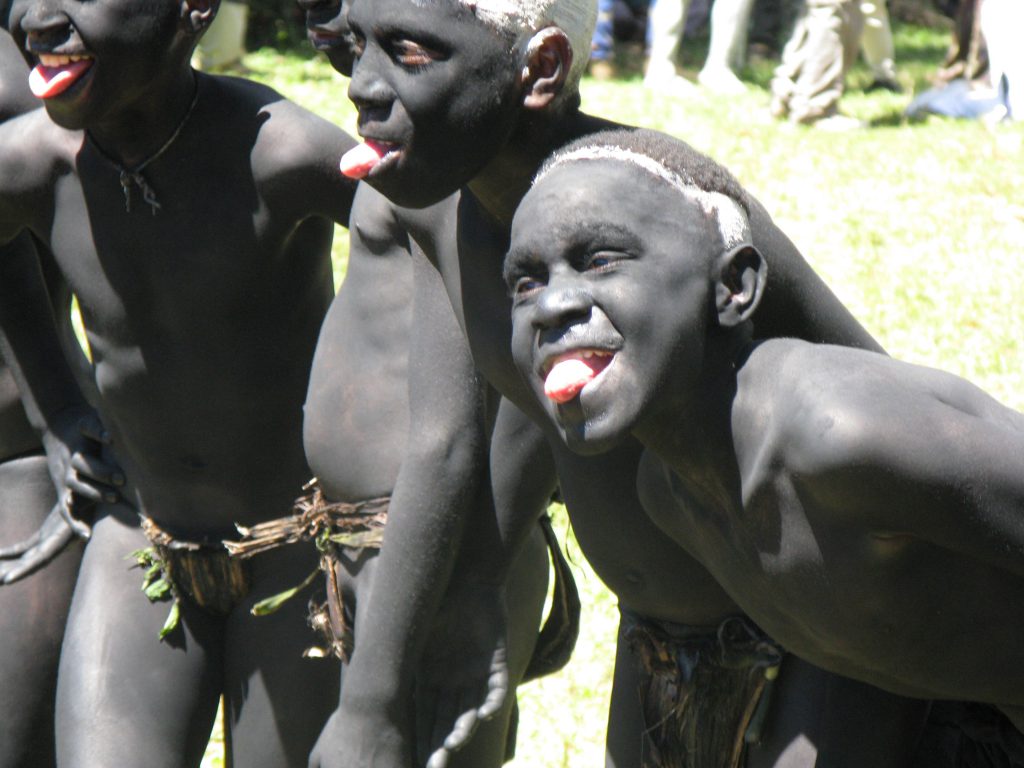
Naughty boys
–and the other were the skeleton boys–again charcoal over their faces and bodies—but with white bones and skull face painted over the charcoal; they walked and danced disjointedly, like one imagines a skeleton would.
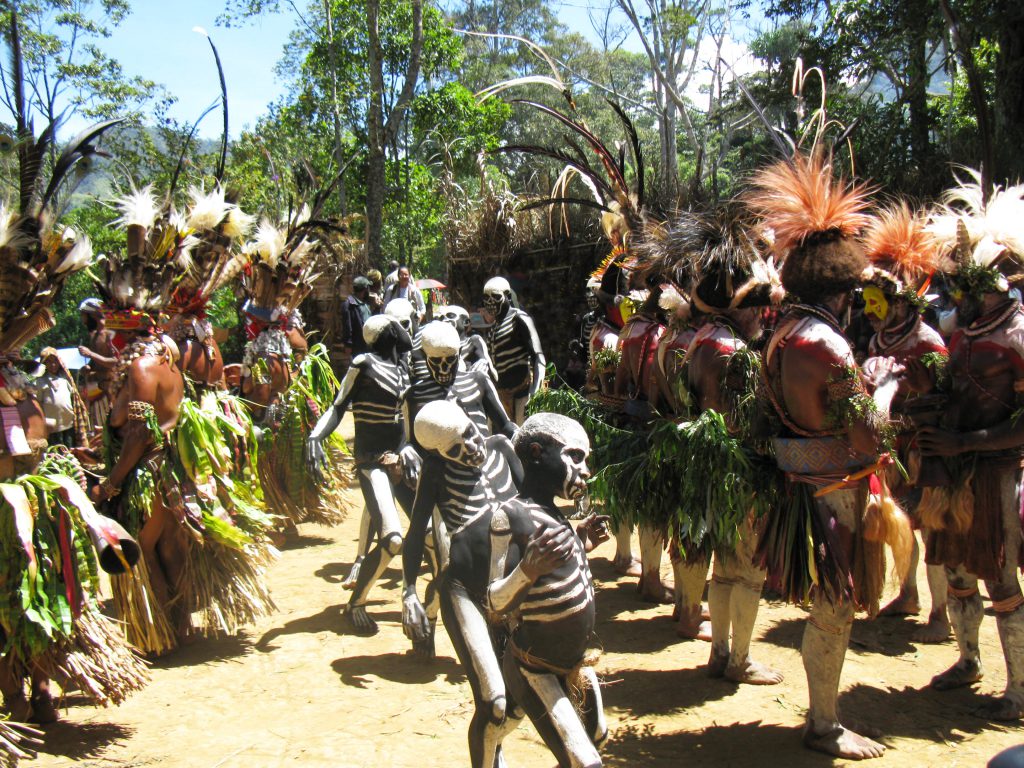
Oma skeleton children, from Mindima village
There were tribes there from as far away as the coast.
Day 4: Waghi Valley. Avi village, Simbu courtship ritual. Overnight Hagen.
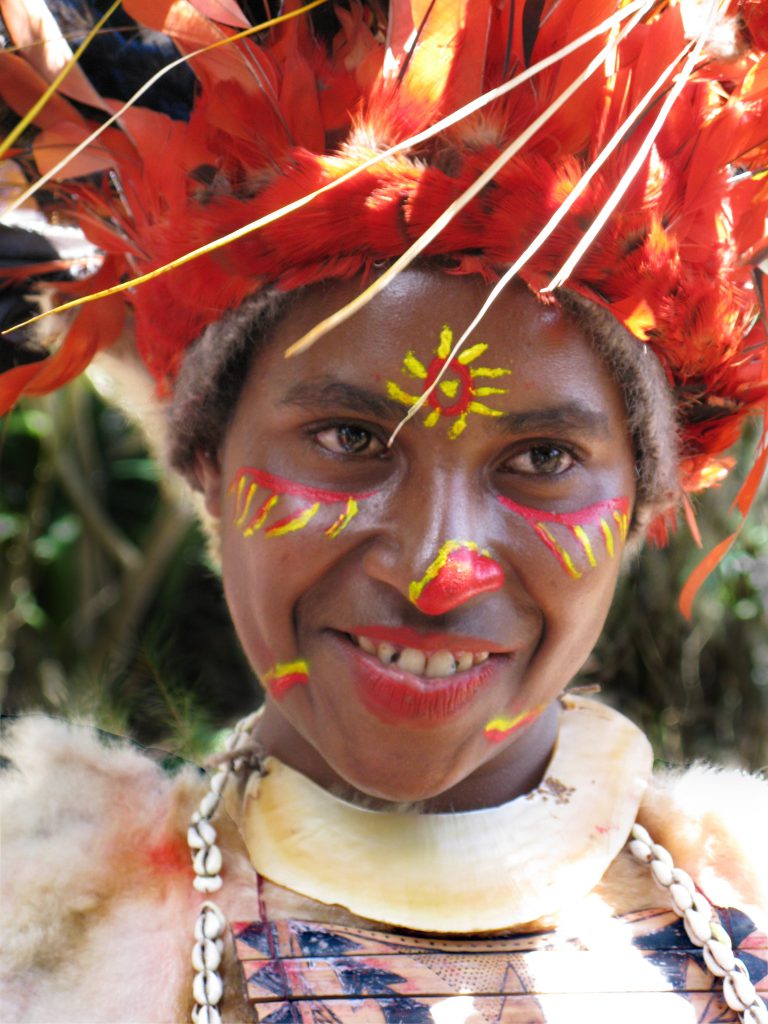
Wedding ceremony bride
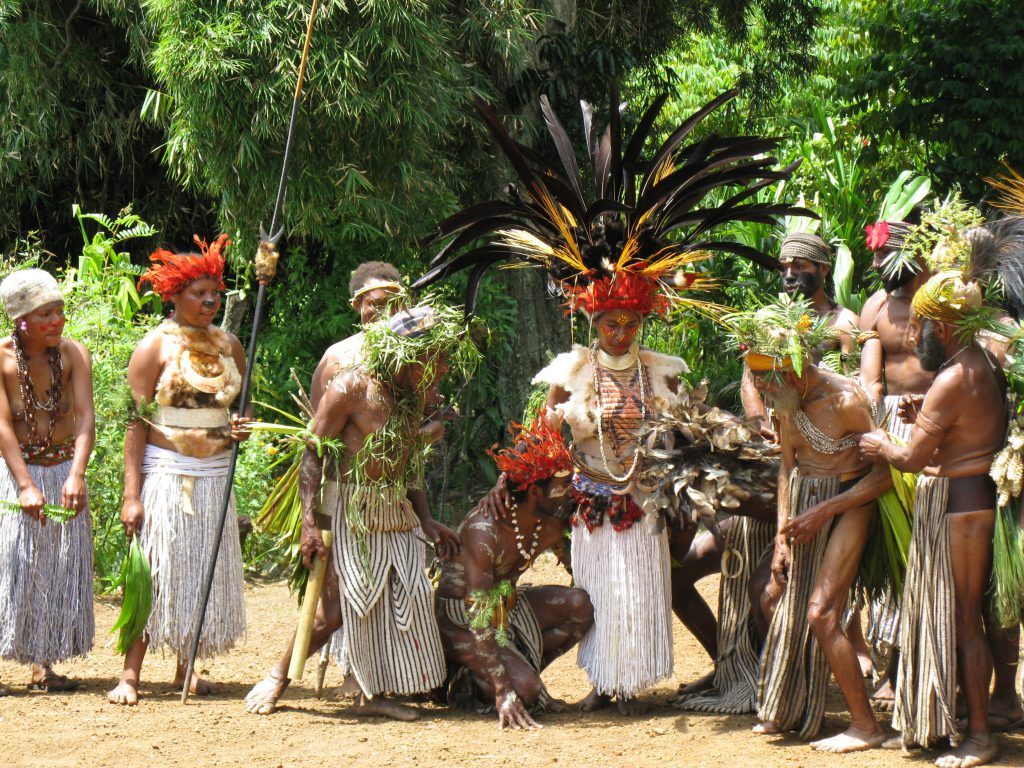
Wedding ceremony
A fun day visiting a village, looking at the well kept farm and their orchid forest.
Then on to watch the Simbu courtship rituals–the turnim hed, karim lek, kukim nus (turn the head, carry the leg, cook the nose). We even got to take part in it and two young women chose to throw their leg over my husband’s. But that was O.K., because I chose a hunk of a guy to throw my leg over, sing, and rub noses with.
Day 5: To Enga province by road.
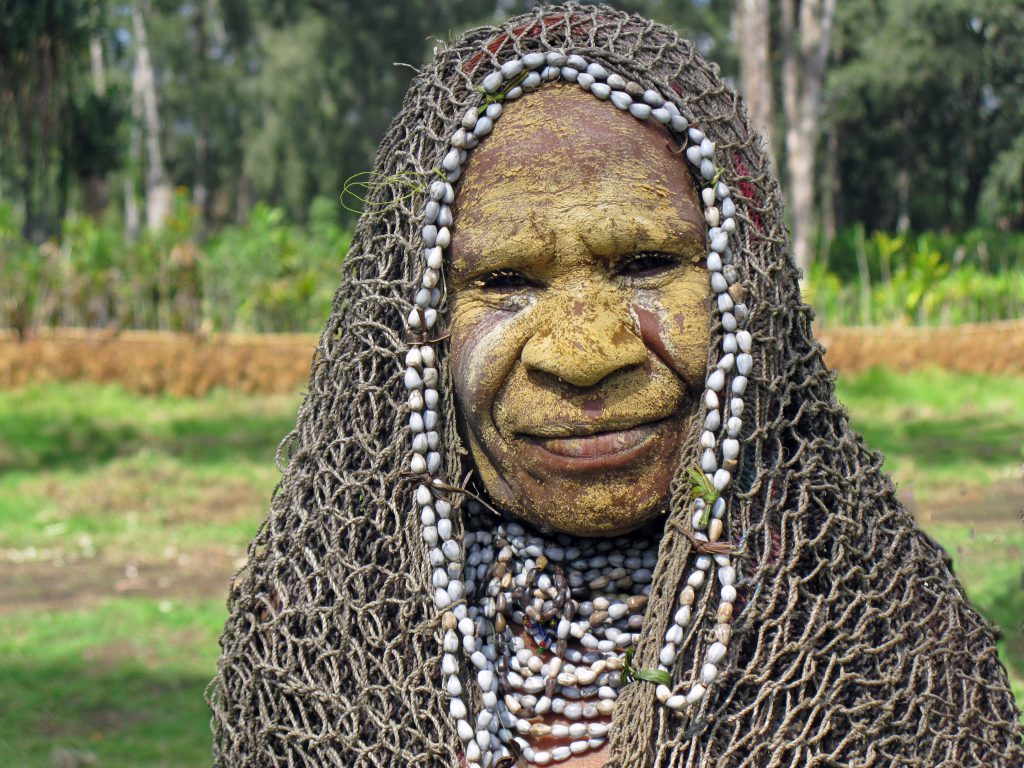
Enga widow
Today, while driving, we saw a field being planted with white (what they call English) potatoes. Instead of dividing the potato with an eye in each piece like we do, the whole potato is planted.
Stopped in at a school—the children had never seen white people before (except in pictures) and were fascinated by us. The principal asked us if we would divide our group up into twos and each pair talk to a class of his students, which we did.
As we walked back to the minibus, everyone poured out of the classrooms, following and laughing and crowding around us, wanting to touch our skin and have us say “hello” to them, then they’d giggle, put their hands over their mouth, and shyly turn their heads away. Being followed by such a noisy, happy bunch of kids, I felt like the Pied Piper.
After a boxed lunch, we visited a hut where the villagers (I think this was Opiyepul village) showed us the skulls and bones of ancestors. They put on a play for us demonstrating how they fought, and how they tracked down a sorcerer who had killed a boy. Afterwards, we were invited to shoot arrows. My husband did fine, but mine just plopped to the ground two inches in front of me—either it’s harder than it looks, I’m a wimp, or both!
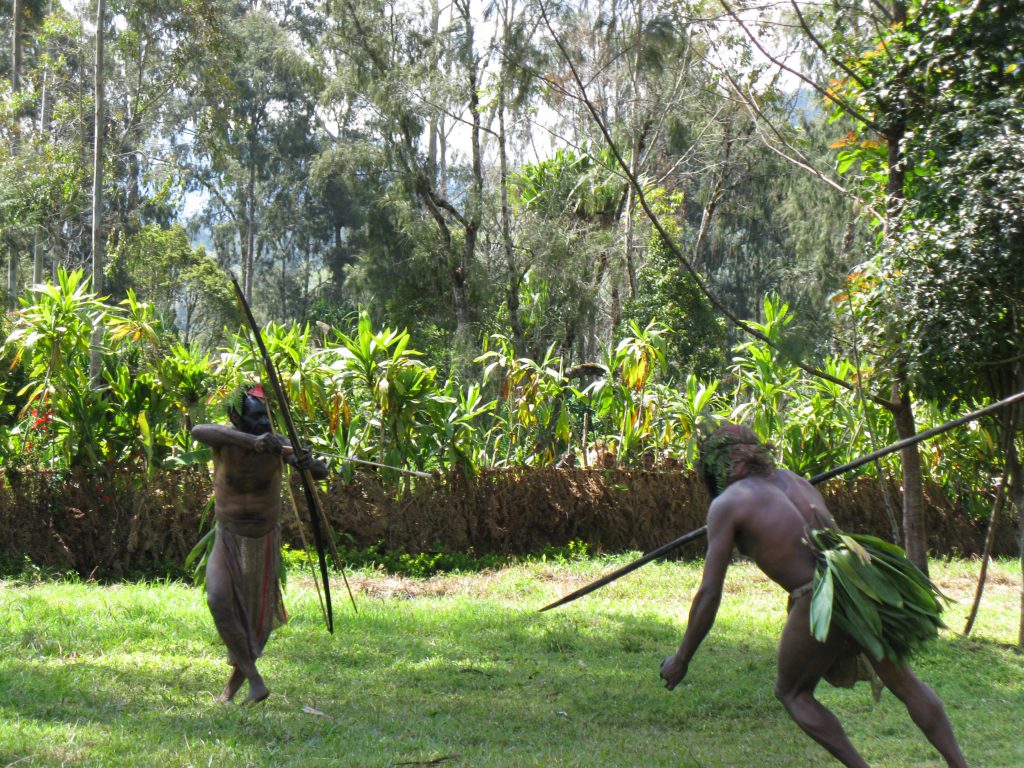
Warriors demonstrating fighting techniques
Day 6: Enga Province
Supposed to be a very big birding area but, except for some at the bird feeders at the Kumul Lodge, didn’t see many at all. Quiet day today. Probably just as well as several of us had a touch of Papua Payback.

Bought some passion fruit from this man
While doing a scenic drive this afternoon, came across a bride price negotiation. Stopped for a while to watch.
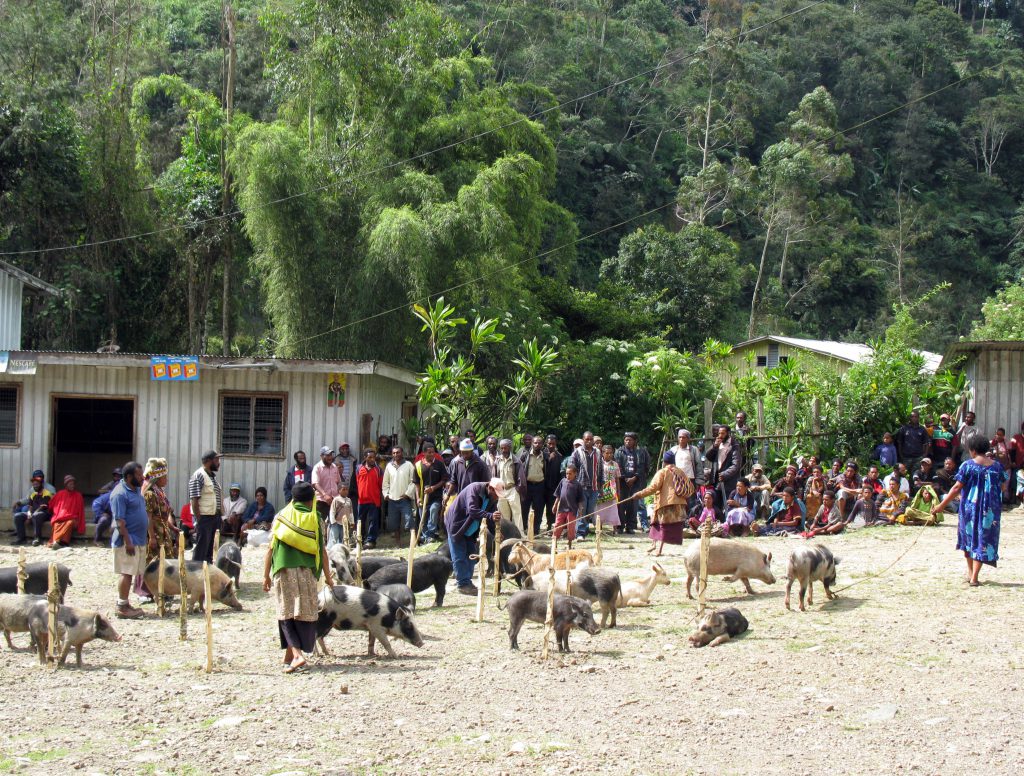
Villagers watching bride price negotiation
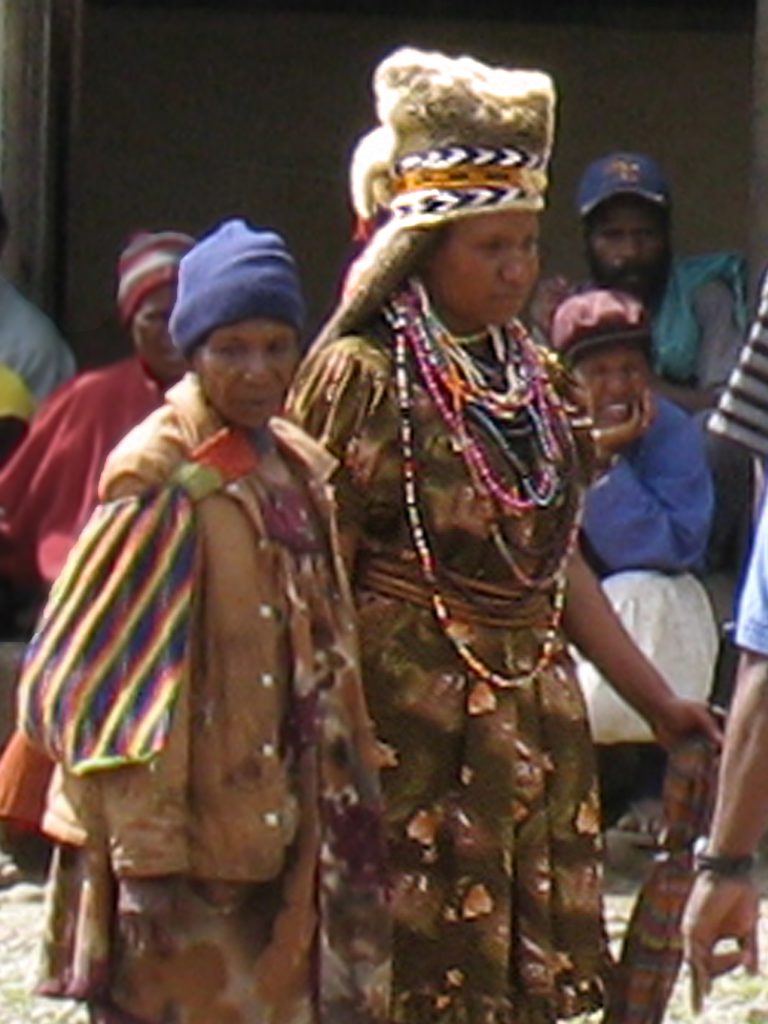
The bride is wearing the furry hat
Day 7: To Goroko by road. JK McCarthy Museum, Raun Raun Theatre.
The JK McCarthy Museum was fascinating. Among its exhibits: how salt was made, pottery styles, weapons, clothing, and the Leahy Wing which houses an interesting collection of photographs.
The outside of the Raun Raun Theatre reminded me of Jabba the Hutt from Star Wars.
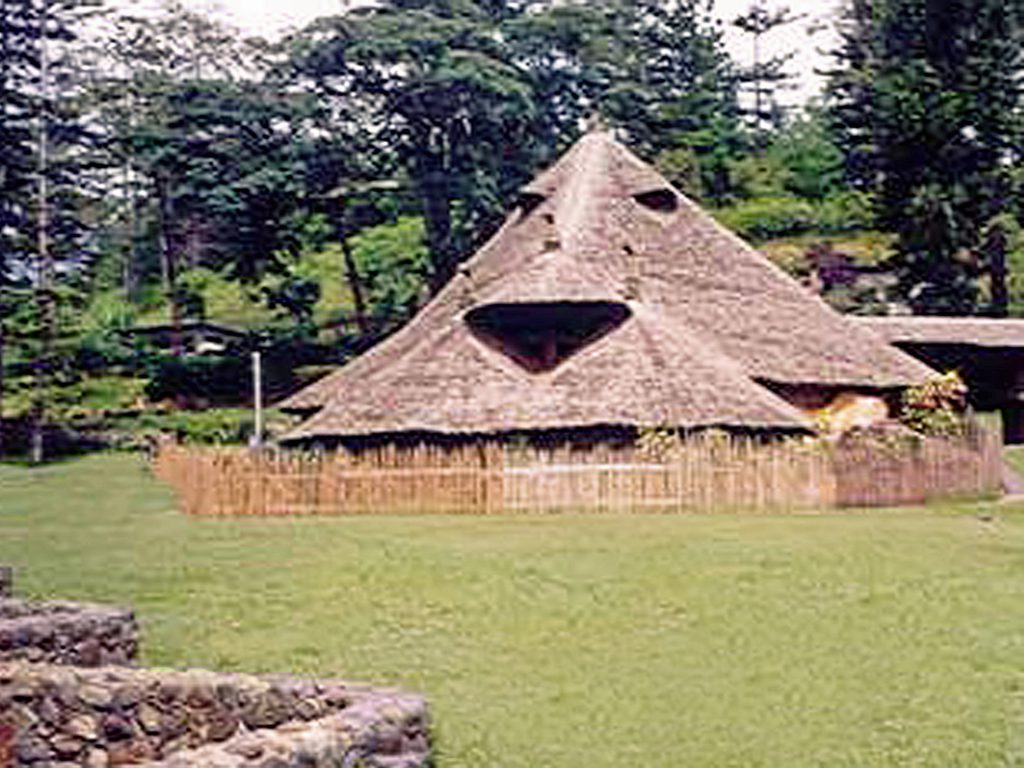
Raun Raun Theatre, Goroko
Inside it was beautifully made and carved of wood, with seats made out of tree trunks cut crosswise. Wish there had been a performance scheduled for that day.
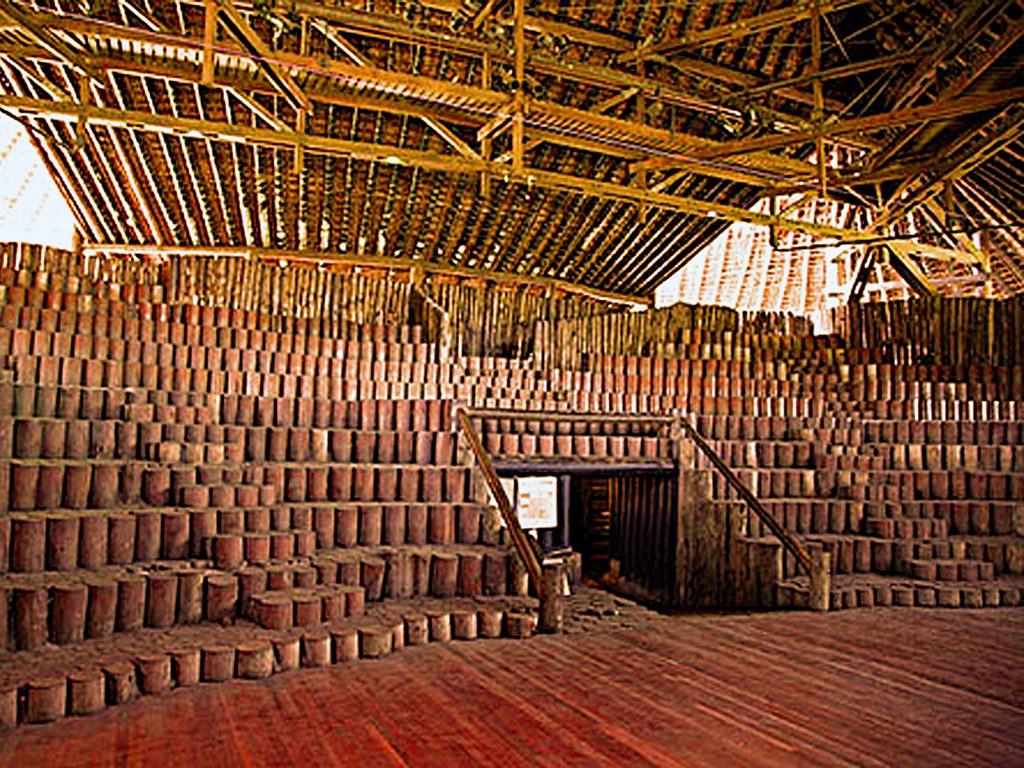
Raun Raun Theatre, seating inside
Day 8: Goroko area: Asaro village.
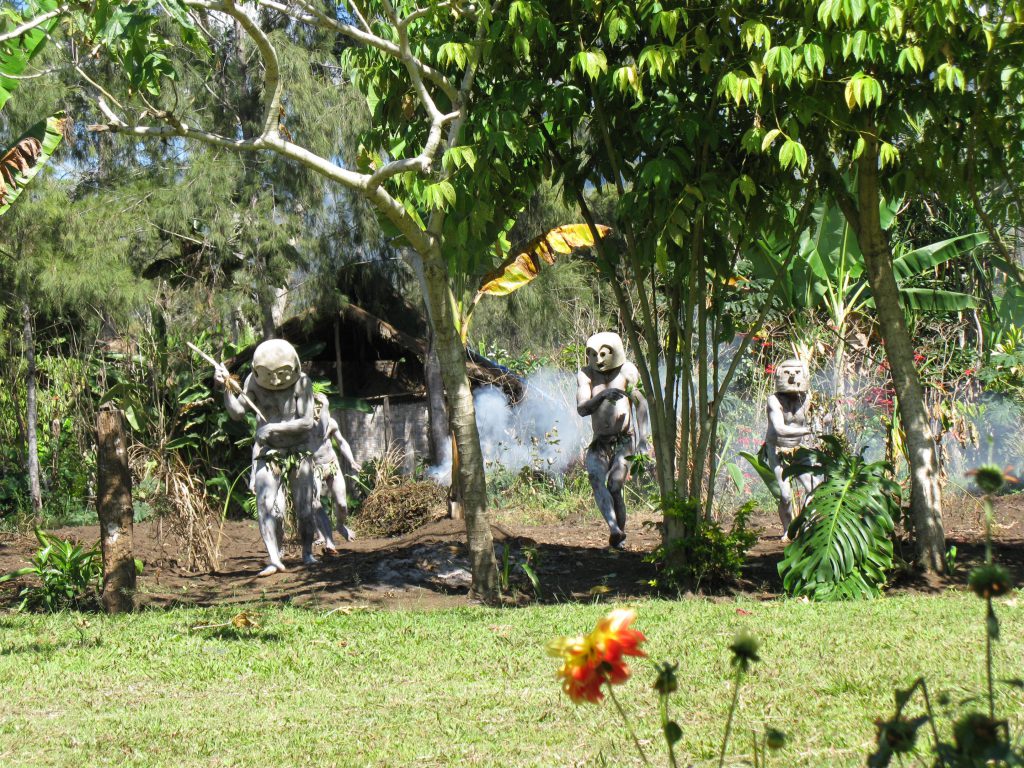
Asaro Mudmen, Asaro Village
The visit to the Mudmen’s village on the Asaro River was a highlight. Their slow movements, grotesque masks, and clicking bamboo claws were eerie as, ghostlike, they materialized through the bushes and smoke of strategically placed fires.
Had heard slightly differing stories on how their look came about. At the village we were told that when they were defeated by an opposing tribe, they ran away and hid in the Asaro River. After dusk, hoping their enemies had gone, they slowly and stealthily, covered in the white clay mud from the river, crept through the bushes to their village. The enemy tribe was still there and, thinking the spirits of the defeated tribe had come to get them, ran away in fear. As time went by, they started making the masks to add to their fearsome appearance, and the bamboo claws. The mud, as it dries and flakes off, looks like the decaying flesh of the dead.
After a very brief shopportunity, their best potter showed us how he made a small mask–I was surprised how long it took, and with how much care he modeled it. As we watched, the young man who chatted with me and took care of my purchases, said he had tried and tried to be able to do that but just didn’t have the skill. He said it is so much more difficult that it looks, so he is going to university to become an accountant.
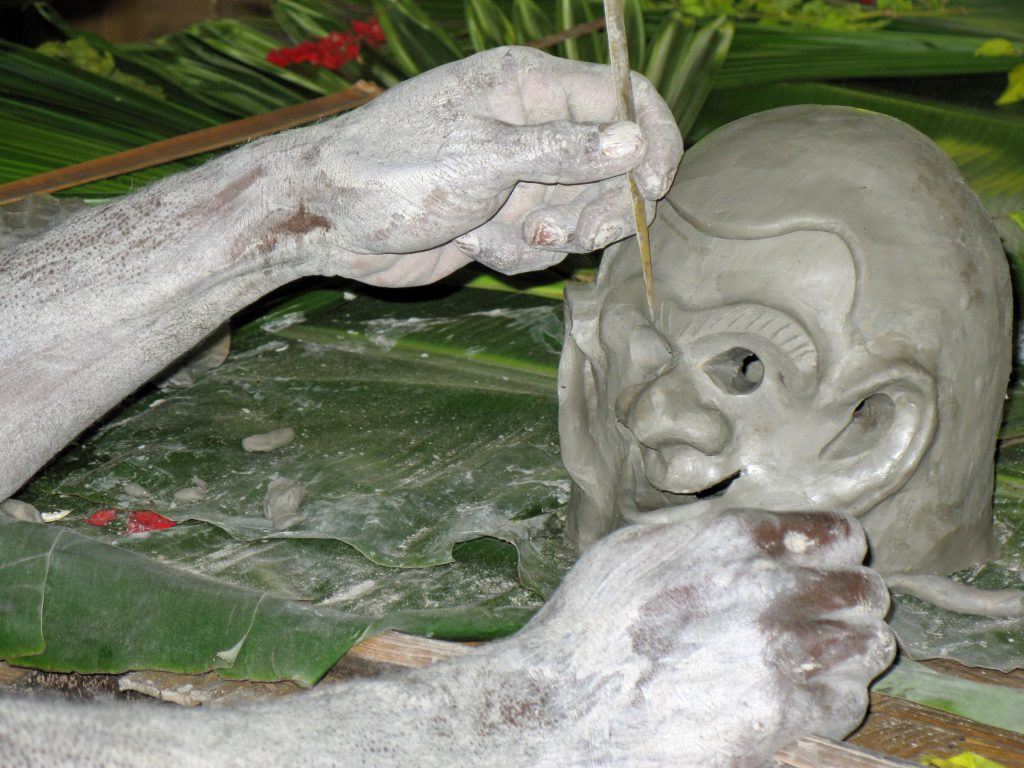
Asaro Village–skilled hands at work
As we watched, the young man who chatted with me and took care of my purchases, said he had tried and tried to be able to do that but just didn’t have the skill. He said it is so much more difficult that it looks, so he is going to university to become an accountant.
Later in the afternoon, we visited a coffee factory and, of course, had to buy some packets of their coffee beans—will bring back such great memories when we drink a cup back home.
Day 9: To Madang by road. Balek Wildlife Sanctuary. Overnight at Jais Aben Resort.
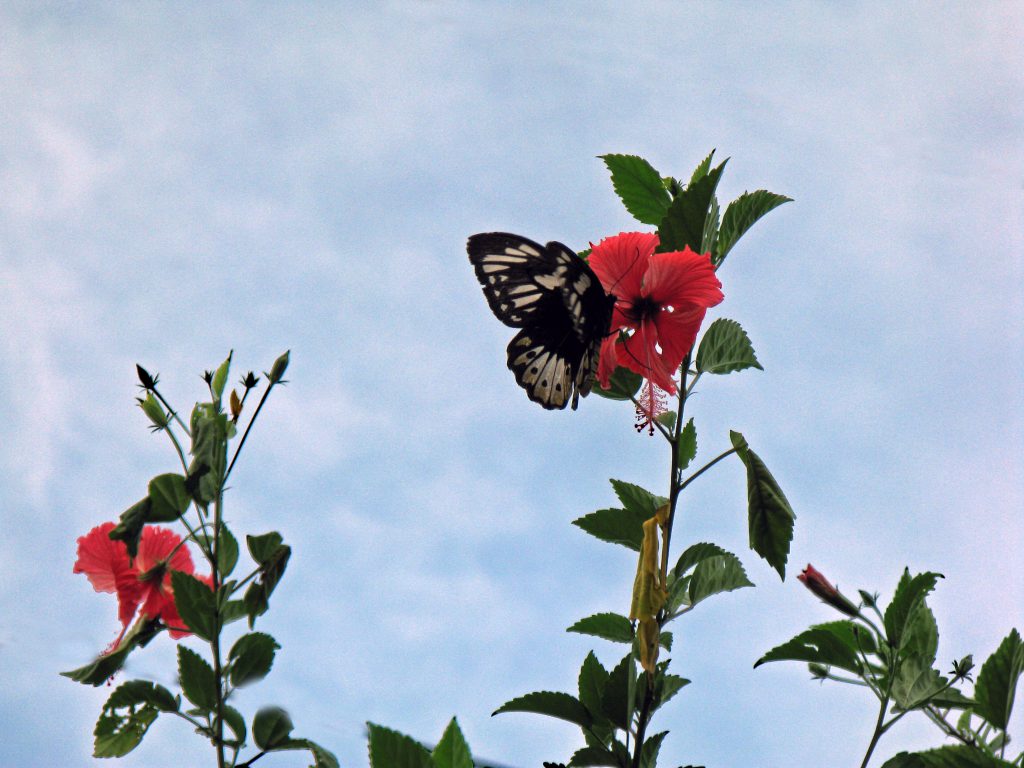
Butterfly at Balek Wildlife Sanctuary
We stopped by the wildlife sanctuary to see their eels and turtles and sulfur springs on the way to Madang–interesting enough but not worth driving out of the way to see.
Would happily have stayed longer at the Jais Aben Resort.
Day 10: Flight to Wewak. Overnight Inwewak Hotel.
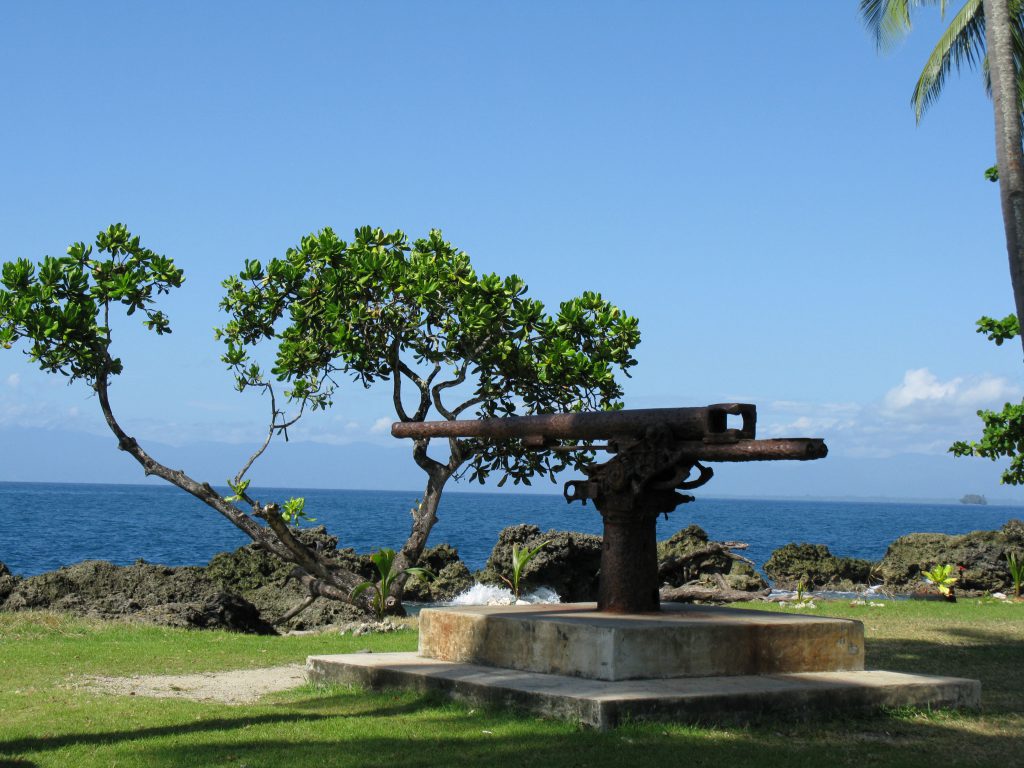
WWII anti-aircraft gun
After watching the sun rise and a leisurely breakfast, we spent the morning in Madang. Saw a WWII Japanese anti-aircraft gun and the Coastwatchers Memorial, a working lighthouse.
For much of the war, Madang was at the center of Japan’s New Guinea territory, so the coast watchers, reporting on Japanese troop and ship movements, were in an extremely dangerous and vulnerable position. Thirty-six coast watchers lost their lives. At the base is a plaque listing the names. The inscription beneath their names: THEY WATCHED AND WARNED AND DIED THAT WE MIGHT LIVE.
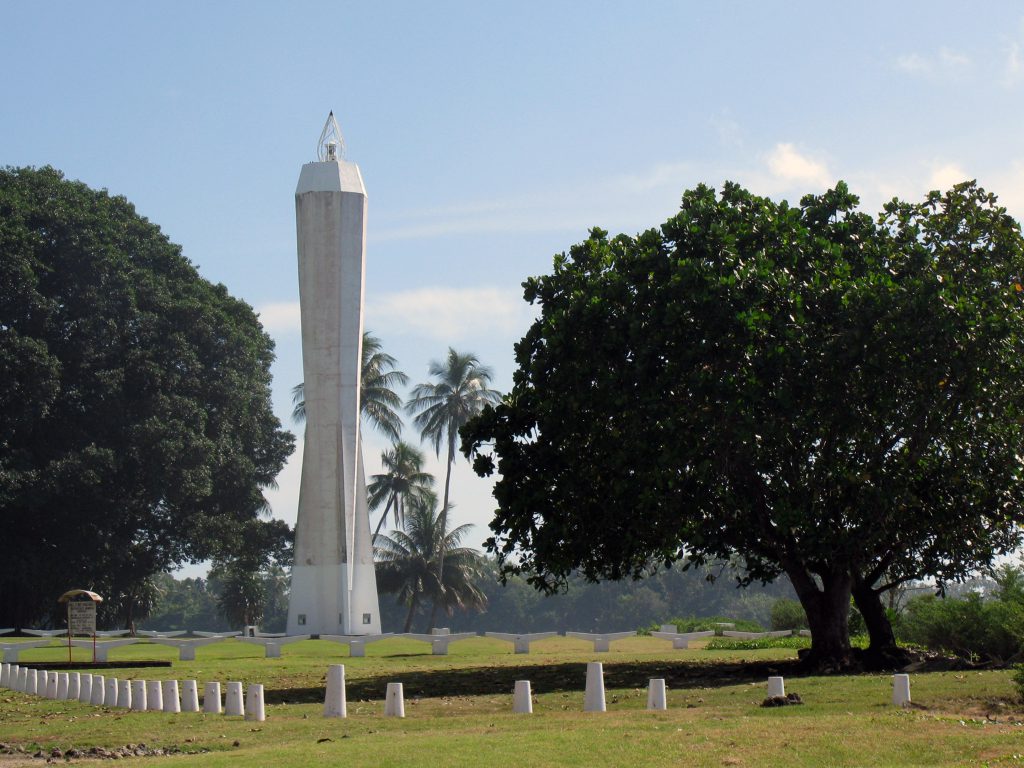
Coast watchers Memorial, Madang
I liked Madang, it had a good feel to it.
Then we flew to Wewak, a nice town and I’d like to return there. The Inwewak Hotel was first class.
Three days on the Sepik River. Overnights in village.
Day 11: Drive to Pagwi, Sepik River.
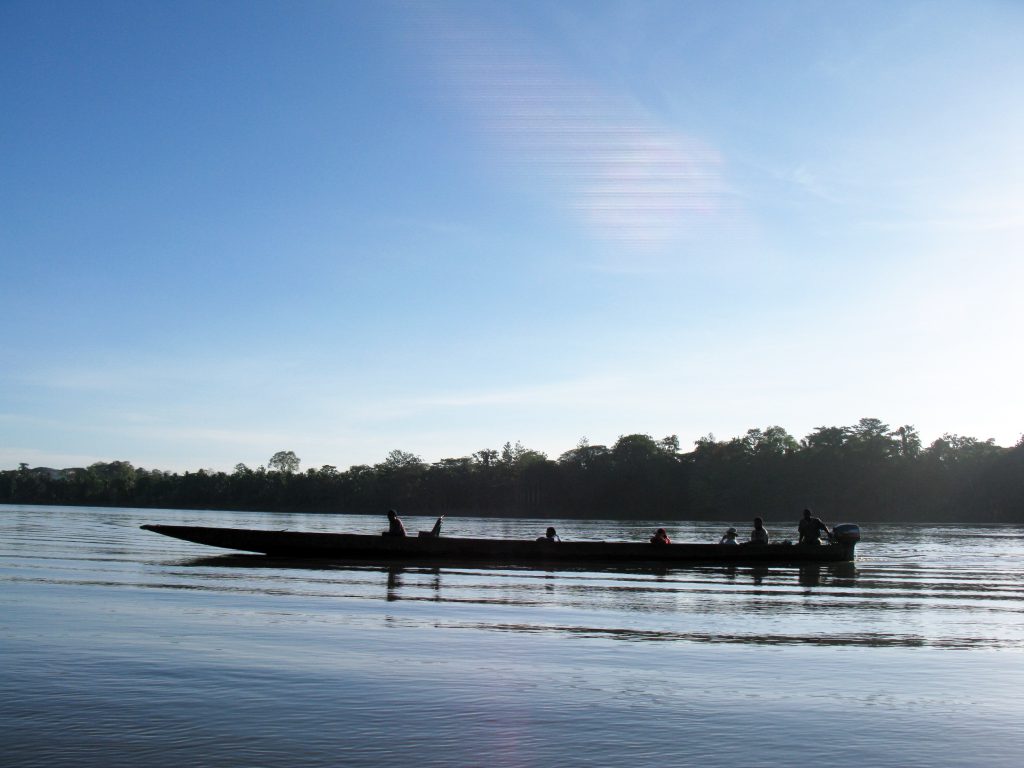
Our two canoes were hand hewn from tree trunks
At the village where we were originally to stay, Nitin didn’t like the outhouse (too full and stinky) and arranged for us to sleep in a village across the river where they had just dug a new one. All our guys were fascinated with the “things” wriggling in it very close to the wooden seat—“The whole surface is moving! Come and look! It’s alive! Come and see!!” I’m game for most anything—but passed on that!
Visited Palimbe village and they did their crocodile dance for us.
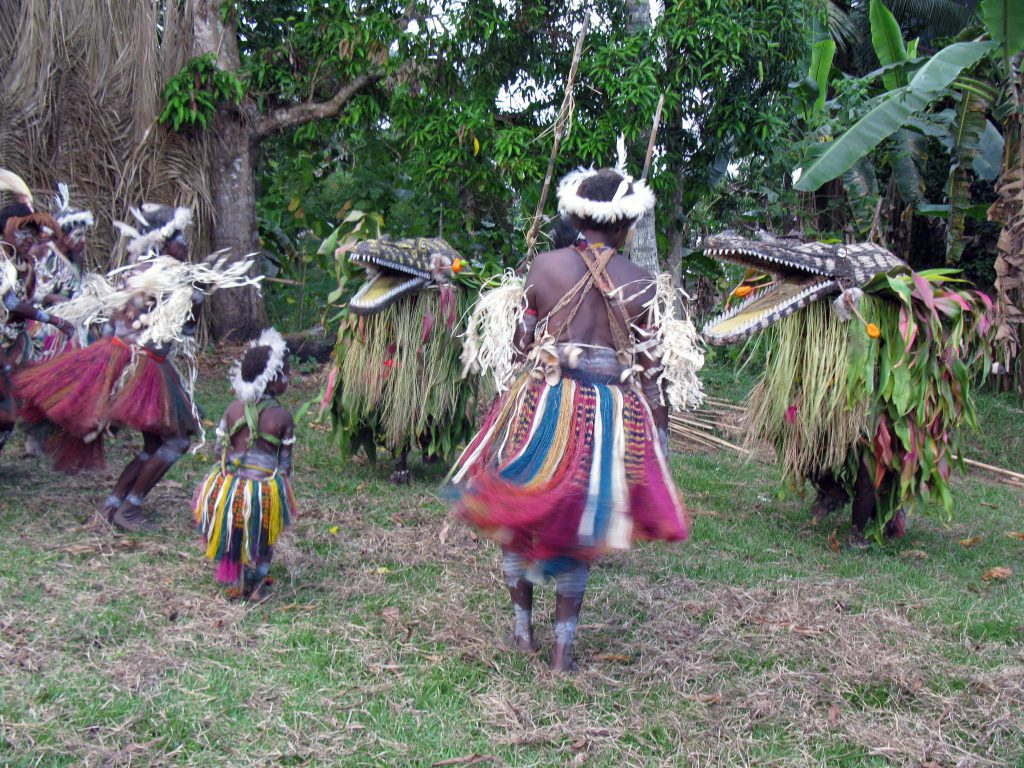
Palimbe Village, crocodile dance
That night the sky was overcast and it was pitch black everywhere except just around the fire. It was time for bed, and time to make a pit stop before climbing up into the hut and under the mosquito netting. The only light to guide me down the path was from my headlamp. (Scary music starts as victim opens the outhouse door–creeeeeaaaakkk.) Carefully, I lift the wooden seat to make sure there’s nothing under that will bite my bum. (Music builds.) Sit down gingerly on the wobbly throne, lift my head and the light strobes on–wham–horror music crescendo—the spider!!! A king kong of a spider. Bigger than Godzilla. The Outhouse Spider!!! Screeeeeeeeeaaaaammm!!!!
Never letting it out of my narrow beam of light, it stays unmoving on the door and doesn’t attack its quivering prey. After slowly and gingerly easing past it on my way out, I stumble back into the firelight and manage to stammer out the warning. After everyone stopped laughing, I’m told it’s quite harmless to humans and does a good job keeping the outhouse free of creepy crawlies. And, from the size of it, I’m sure that’s true.
So….I head back with my camera and discover it’s really only as big as my outstretched hand (which is still plenty big IMHO). And, it’s going to have babies. From the number of eggs under it, there will be the patter of many, many, many little feet.
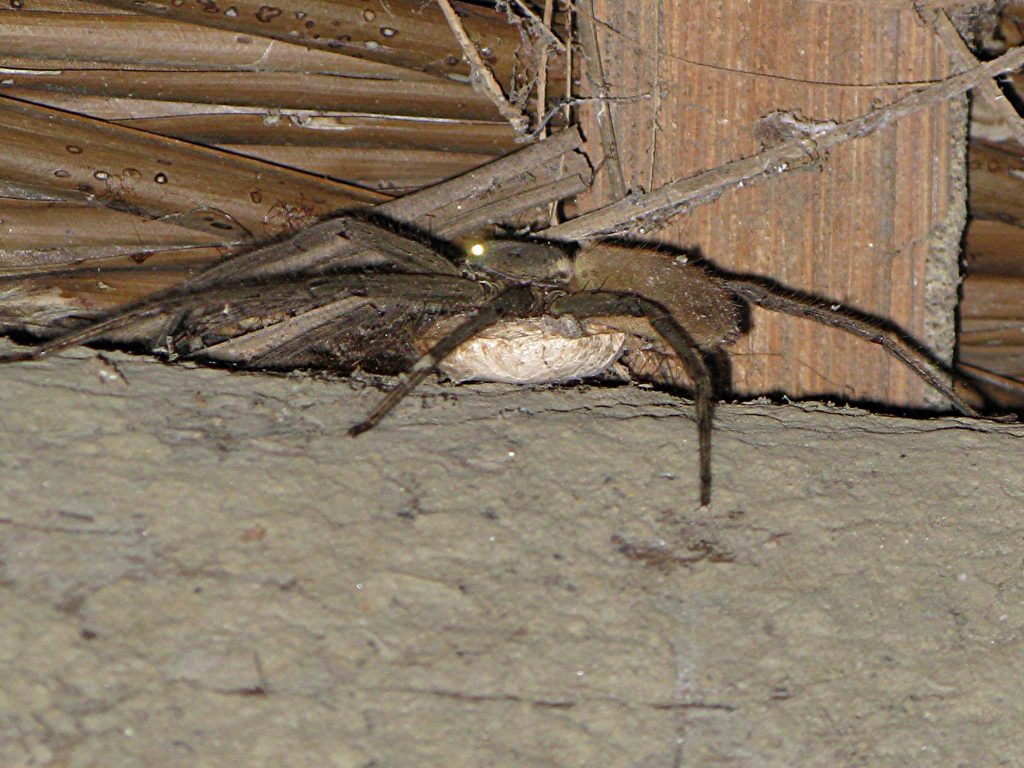
Outhouse spider, with eggs underneath
Day 12: Aibom, Chambri Lakes. Overnight village.
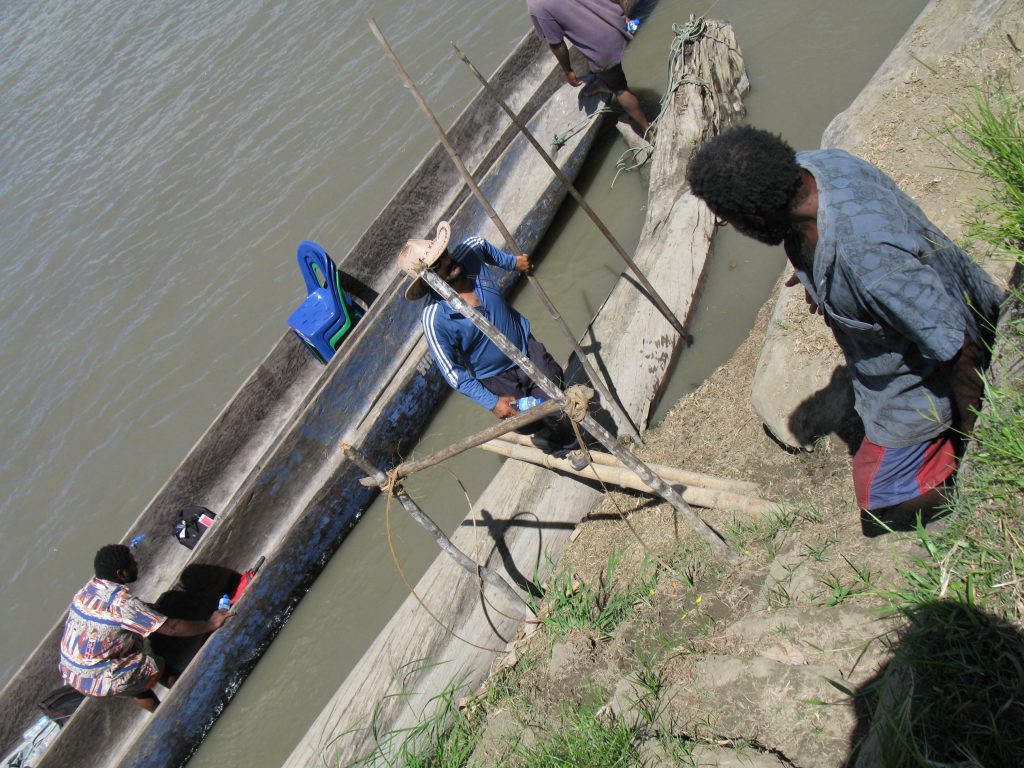
Quite a climb down to our canoes
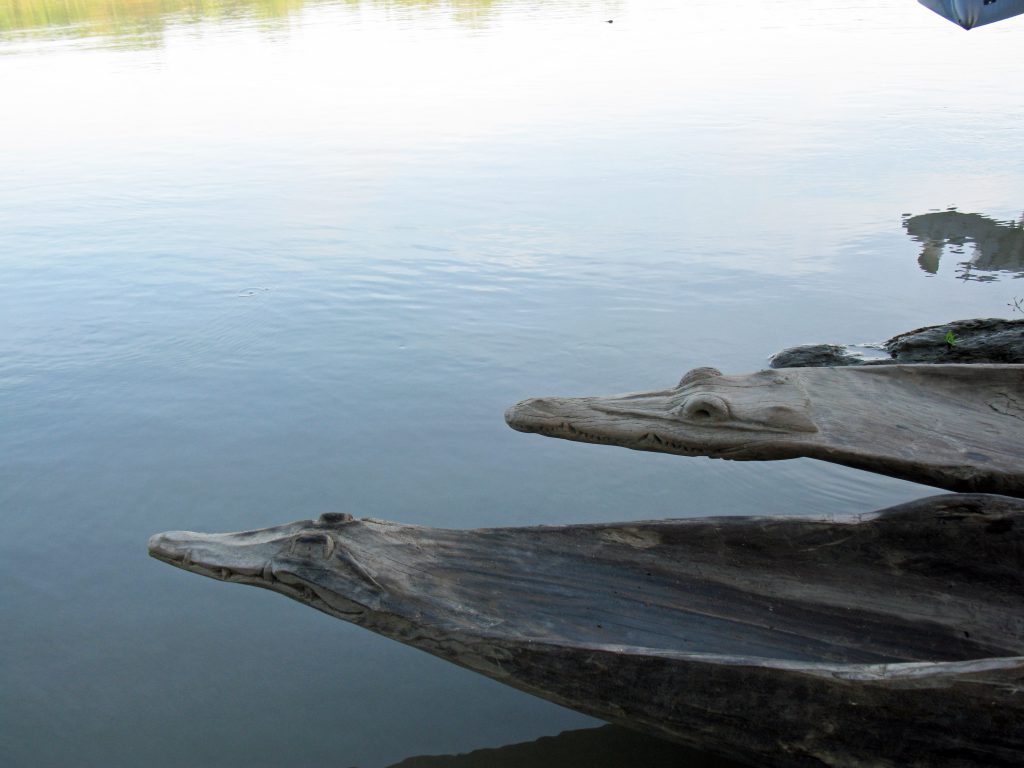
Alligator prows of our canoes
We had a fry-up for breakfast—fried slices of the canned pork luncheon meat, fried eggs, fried onions, fried potatoes, even fried bread. Yum—my kind of breakfast.
Visited several more villages today including Aibom where a young woman showed us how they made their clay pots. Another village we stopped at had the most fantastic carvings.
Sleeping on the floor of a hut on stilts, next to the Sepik River was a great experience.
Day 13: Canoe back to Pagwi, then by road to Wewak. Overnight at Inwewak Hotel.
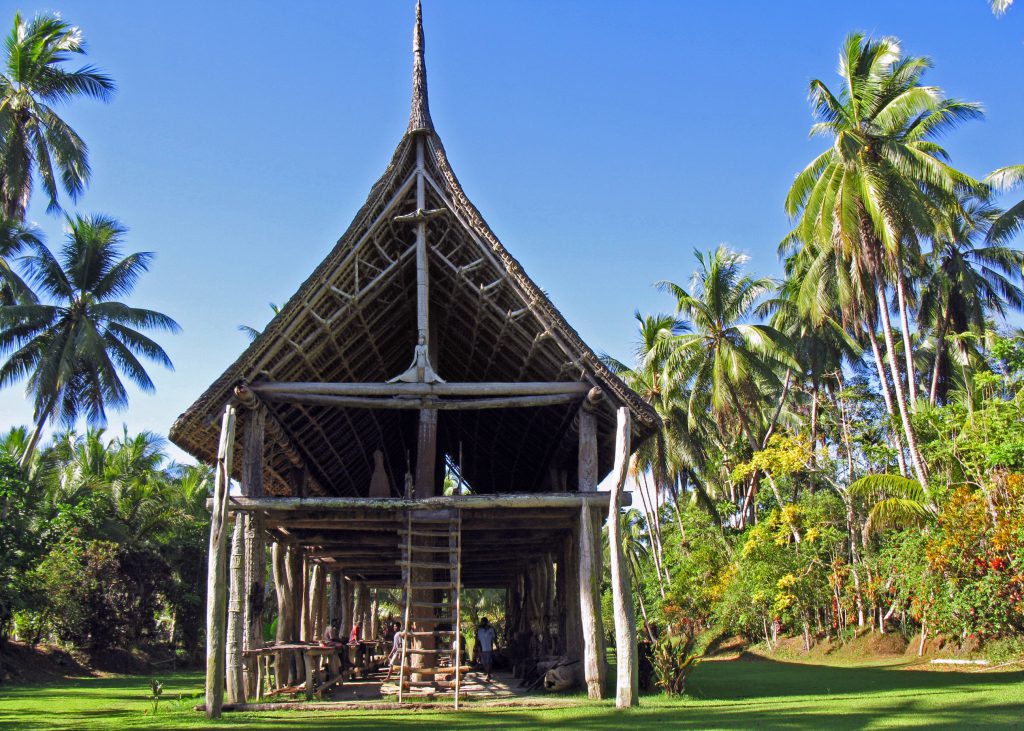
Haus Tambaran aka Spirit House
We saw a village this morning that had bullet holes in the trunks of the trees supporting the Spirit House. They were made by U.S. planes during WWII when the village was occupied by Japanese troops. One of the young men I talked to said his father and the other old men tell horror stories of the cruelty of the Japanese during that time, which he had a difficult time believing because the Japanese who come to the village these days are their most favorite visitors–polite, pleasant and generous. He just couldn’t understand how they could be so different then, than now. I told him that war can make decent people do things they wouldn’t normally do and which, at a later time, they may very much regret having been involved in.
On our return to Wewak, the folks at the Inwewak cooked us a meal of traditional foods, including fried sago palm grubs. “Think of it as a shrimp” was how I managed to eat one. It was tough outside, squishy inside, and tasted like liquorice or aniseed. I don’t like liquorice, or aniseed flavors, or squishy insides, so didn’t try another.
Day 14: Fly from Wewak to Port Moresby. Rouna Falls, Bomana WW II cemetery.
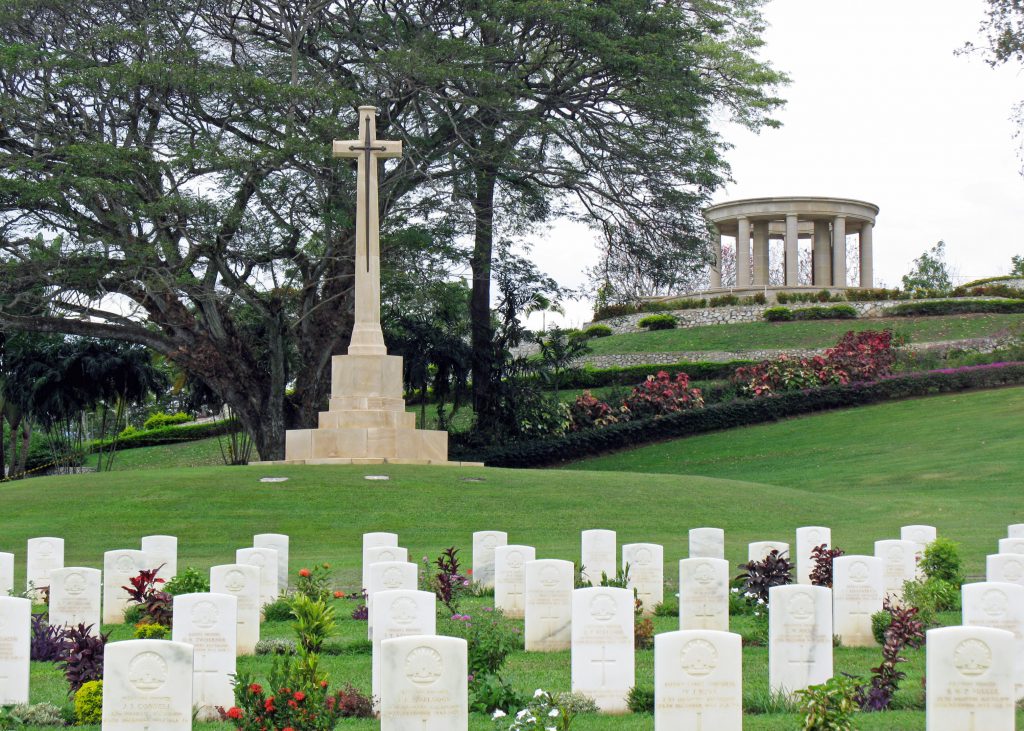
Bomana WWII cemetery
Bomana cemetery is well kept, with a plaque showing the Kokoda Trail. I’m going to rant a bit now–I believe the megalomaniac, power hungry people who start wars such as WWII are truly, truly evil. I felt that way when I stood on Normandy Beach in France and couldn’t keep the tears away, and felt it here in so many places, too. We met a man from Tasmania whose dad had died on the Kokoda Trail. He was a newborn at the time so never knew his dad and was going on a group trek with some other Australians whose fathers had also died on the trail while trying to keep the Japanese troops from getting overland to Port Moresby.
While we were in the Trobriands, a few days later, one of the local men brought us an American soldier’s WW2 dog tag he’d found.
Day 15: Port Moresby. National Parliament, National Museum, Botanical Gardens, Hanuabada stilt village, fish market.
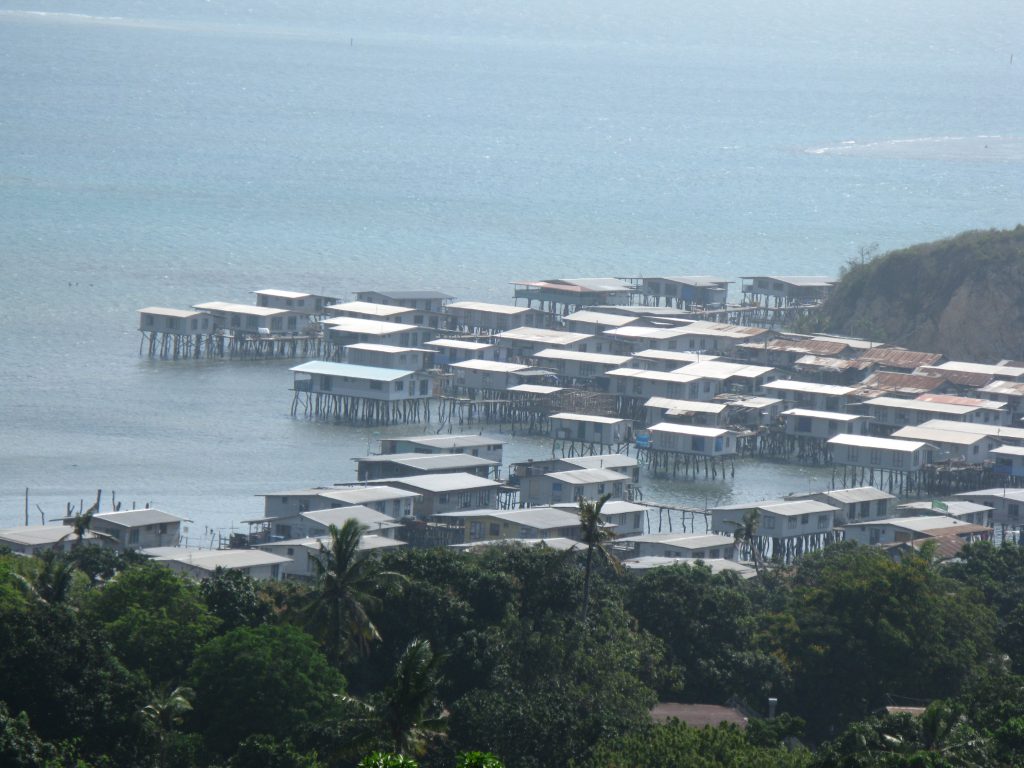
Hanuabada stilt village
The people of Hanuabada stilt village were most pleasant and showed us around. One of our group’s hat got blown off by the wind into the ocean and a boy of not more than eight immediately jumped in, swam after it, and brought it back. The people live mostly from harvesting the sea.
What a fascinating place the National Museum is–they’ve done a fantastic job. We spent about an hour and I would have happily spent many more hours there. The National Parliament is impressive, and the Botanical Gardens gave us a chance to see the Raggiana Bird of Paradise, the national bird.
Days 16, 17 and 18: Fly to Kiriwina Island, Trobriands. Overnights at Butia Lodge.
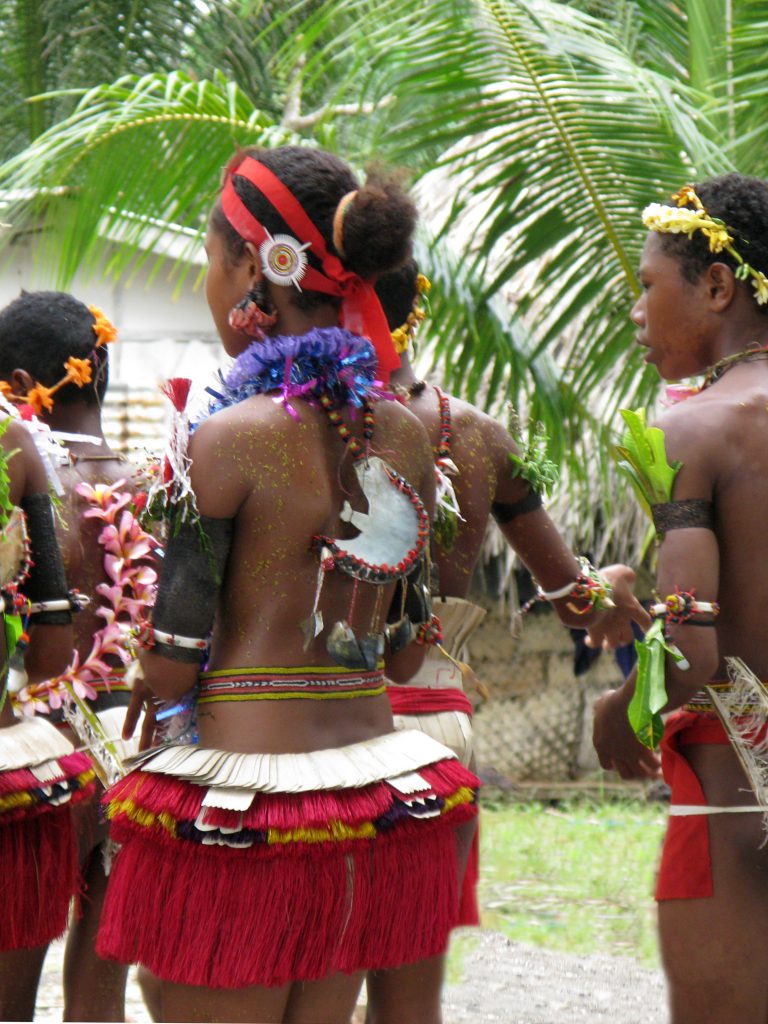
Traditional costume
I hadn’t been expecting much from this part of the trip, but these three days were just as wonderful as the previous part. It had been raining a lot before we came and the locals were starting to be concerned about getting their planting in.
Most of the people look Polynesian, and their traditional costumes (grass skirts for the women and loin coverings for the men) and their dancing also reflect that–the body above the waist remains fairly stationary while the hips do the moving. They are softly spoken. They are scrupulously clean–never smelled one sweaty armpit. Unfortunately, like on the mainland, quite a few people do chew betel nut, so their teeth are discolored.
From what I could see, there is little opportunity for paid employment; the adults work their gardens, fish, and sometimes sell their crafts. The men do the carving, and very highly skilled it is, too. I saw some exquisite work, the wood highly polished, carefully carved, often with inlaid mother of pearl and some with cat’s eyes (lid of the sea snail, Turbo smaragdus).
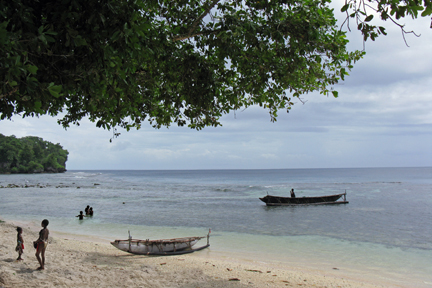
Above is the beach where we had lunch, rode in an outrigger canoe, and enjoyed the dancing of young people from the local school (below).
Some of the things we did:
- had lunch on the beach;
- took outrigger rides;
- watched school kids in traditional dress dance;
- saw structures where yams are stored and saw one huge yam, must have been 5 foot long, being carried down the road by two young men;
- spent some time with villagers who were getting ready for a memorial ceremony and feast in remembrance of their chief’s brother who had died the previous year, with baskets and baskets of banana leaf money stacked around the village central ground;
- visited the local hospital and a school;
- and on our final evening the staff of the Butia Lodge put on a cultural show for us.
Day 19: Kiriwina. To Port Moresby.
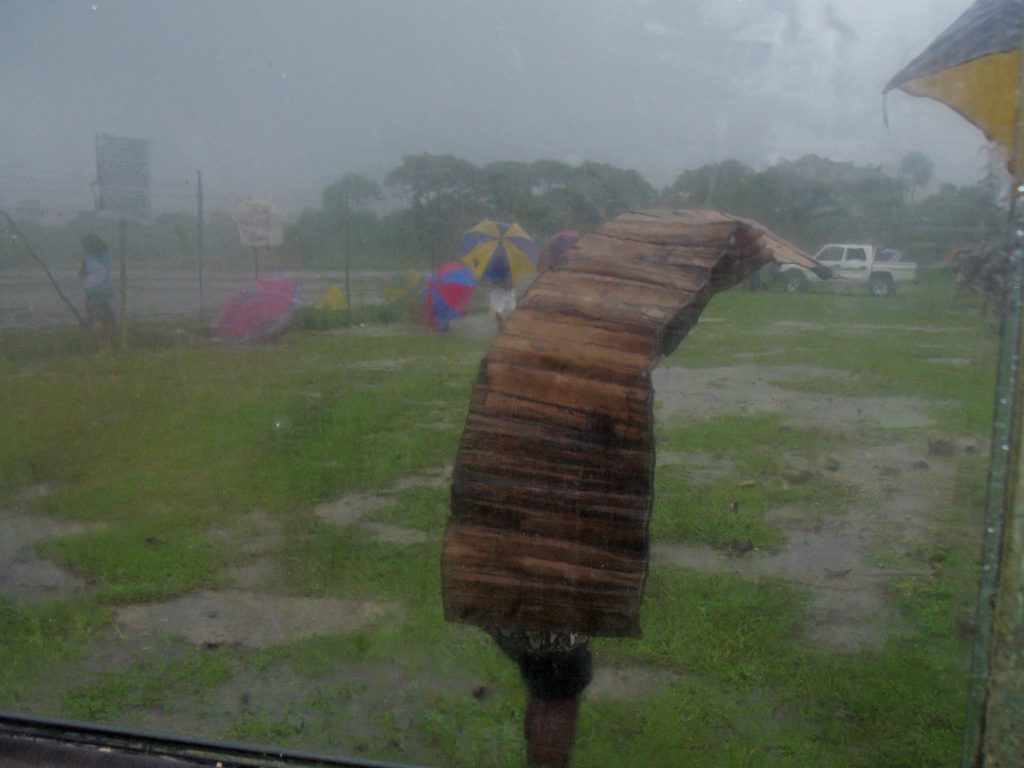
Home made umbrella at the airport on Kiriwina
It was pelting down with rain while we were waiting for our plane to arrive to fly us back to Port Moresby, and there was some question whether it would be able to land but (unfortunately!) the rain did ease off enough for it to do so.
In Port Moresby, after the goodbye party, it was time to return to our rooms and do some last minute rearranging. Upon arriving back home, of the three mudmen statues I bought in the village, only one needed surgery to reattach an arm and a leg. As carefully as my husband had packed them, I still hadn’t believed they’d make it without being in a thousand pieces.
Day 20: Fly home.
Another long, but uneventful–the best kind–trip home.
Notes after returning home:
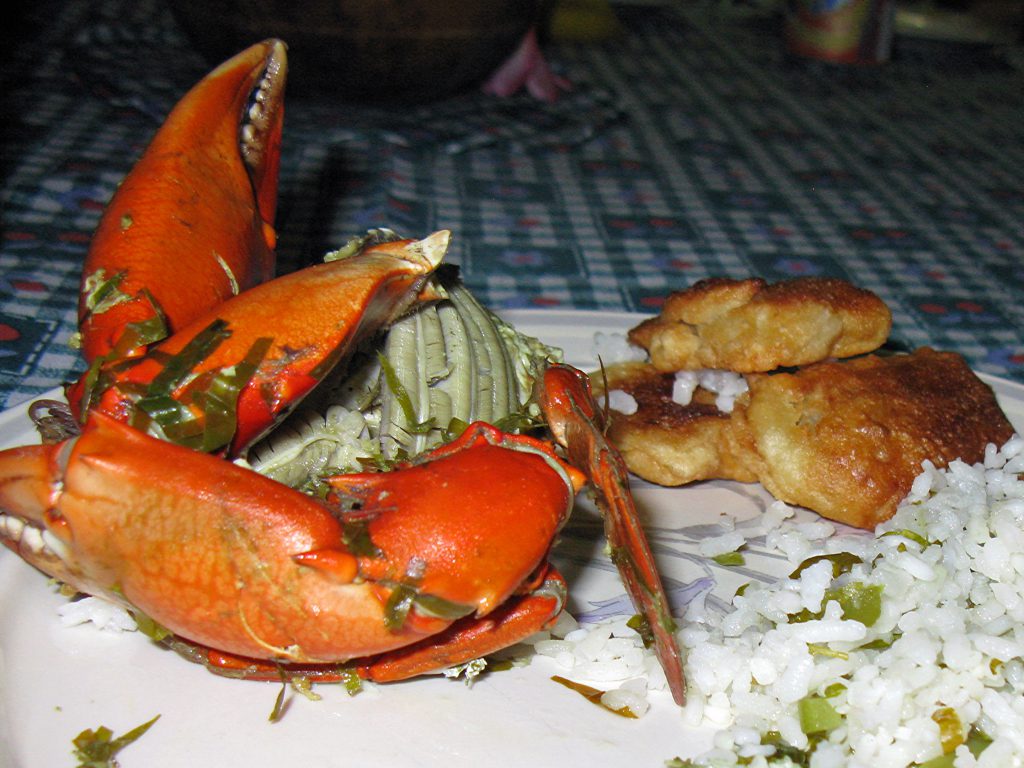
All the crab we could eat. To the right, above the rice, is an extremely delicious kind of fry bread.
While on Kiriwina, I couldn’t get used to being encouraged to eat all the crab I wanted, and there were heaping platters of it. Here in Colorado it is horrendously expensive, but I suppose there it is cheap eats.
A fruit I ate for the first time on this trip was the pommelo—I really gorged on them. The fruit looked like grapefruit but with fatter whatever-you-call-the-juicy-little-globes-that-are-inside, and didn’t have a grapefruit taste–very mellow and refreshing. I bought some from the supermarket when I returned home but, although similar in looks, they were more tart and grapefruity tasting. I’ve since read that when grown here in the USA, they do taste like grapefruit and it was suggested this might be because of the difference in soil.
We all got very good at pretending we couldn’t feel the little hands of preschool children touching our legs, I suppose to see if the white would rub off, and then hearing their mothers or older children gently scolding them. I’m glad we all knew that the excited shouts of, “Dimdim! Dimdim!” by the children, didn’t mean what it sounds like to us, although it may have been correct.
Papua New Guinea is a very expensive place to visit; however, the logistics of getting around in a timely manner requires flying between many places.
I’ve been to a great many countries and this was my second visit to PNG (first time was with Trans Niugini) but, unless I was going to stay in one place such as Madang, I wouldn’t dream of doing it by myself. Eldertreks and Trans Niugini are both first class operations. Both times I know we saw more, learnt more, and had many more good experiences than we would have if we’d tried to do it on our own.
If you can make it to PNG, the experience, both under and above water, is unforgettable.
A montage of some more photos from this trip:
